Japanese Beetles in the Urban Landscape
ENTFACT-451: Japanese Beetles in the Urban Landscape | Download PDF
by D.A. Potter, M.F. Potter, and L.H. Townsend, Extension Entomologists
University of Kentucky College of Agriculture
The Japanese beetle is probably the most devastating pest of urban landscape plants in the eastern United States. Japanese beetles were first found in this country in 1916, after being accidentally introduced into New Jersey. Until that time, this insect was known to occur only in Japan where it is not a major pest.
The eastern US provided a favorable climate, large areas of turf and pasture grass for developing grubs, hundreds of species of plants on which adults could feed, and no effective natural enemies. The beetle thrived under these conditions and has steadily expanded its geographic range north to Ontario and Minnesota, west to Iowa, Missouri and Arkansas, and south to Georgia and Alabama.
The first Japanese beetles discovered in Kentucky were found on the southern outskirts of Louisville in 1937. Isolated infestations were treated with insecticides to delay spread of the beetle. During the 1950s and 1960s, beetle populations increased dramatically and spread in Kentucky and surrounding states. Today, the Japanese beetle infests all of the counties in Kentucky.
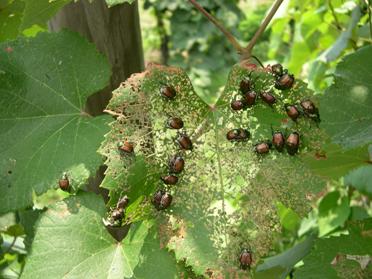
Leaves skeletonized by Japanese beetles
Description and Habits
Adult Japanese beetles are 7/16-inch long metallic green beetles with copper-brown wing covers. A row of white tufts (spots) of hair project from under the wing covers on each side of the body.
Adults emerge from the ground and begin feeding on plants in June. Activity is most intense over a 4 to 6 week period beginning in late June, after which the beetles gradually die off. Individual beetles live about 30 to 45 days.
Japanese beetles feed on about 300 species of plants, devouring leaves, flowers, and overripe or wounded fruit. They usually feed in groups, starting at the top of a plant and working downward. The beetles are most active on warm, sunny days, and prefer plants that are in direct sunlight. A single beetle does not eat much; it is group feeding by many beetles that results in severe damage.
Adults feed on the upper surface of foliage, chewing out tissue between the veins. This gives the leaf a lacelike or skeletonized appearance. Trees that have been severely injured appear to have been scorched by fire. Japanese beetles may completely consume rose petals and leaves with delicate veins. Odors emitted from beetle-damaged leaves seem to be an important factor in the aggregation of beetles on particular food plants.
Adult Japanese beetles are highly mobile and can infest new areas from several miles away. Usually, however, they make only short flights as they move about to feed or lay eggs.
Life Cycle
Egg laying begins soon after the adults emerge from the ground and mate. Females leave plants in the afternoon, burrow 2 to 3 inches into the soil in a suitable area, and lay their eggs--a total of 40 to 60 during their life. The developing beetles spend the next 10 months in the soil as white grubs. The grubs grow quickly and by late August are almost full-sized (about 1 inch long). Grubs feed on the roots of turfgrasses and vegetable seedlings, doing best in good quality turf in home lawns, golf courses, parks, and cemeteries. However, they can survive in almost any soil in which plants can live.
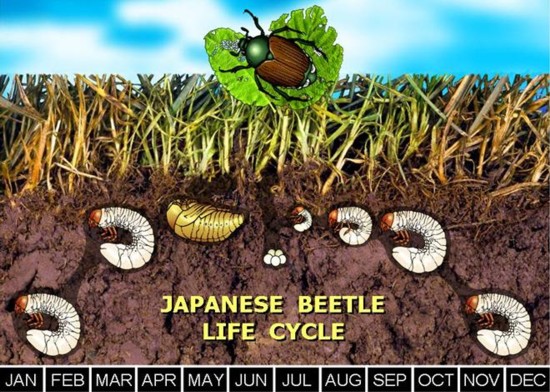
Mid-summer rainfall and adequate soil moisture are needed to keep eggs and newly-hatched grubs from drying out. Females are attracted to moist, grassy areas to lay their eggs; thus, irrigated lawns and golf courses often have high grub populations, especially during otherwise dry summers. Older grubs are relatively drought resistant and will move deeper into the soil if conditions become very dry. Japanese beetle grubs can withstand high soil moisture, so excessive rainfall or heavy watering of lawns does not bother them.
As Japanese beetle grubs chew off grass roots, they reduce the ability of grass to take up enough water to withstand the stresses of hot, dry weather. As a result, large dead patches develop in the grub-infested areas. The damaged sod is not well-anchored and can be rolled back like a carpet to expose the grubs. If the damage is allowed to develop to this stage, it may be too late to save the turf. Early recognition of the problem can prevent this destruction.
Japanese beetles overwinter in the grub stage. When the soil cools to about 60°F in the fall, the grubs begin to move deeper. Most pass the winter 2 to 6 inches below the surface, although some may go as deep as 8 to 10 inches. They become inactive when soil temperature falls to about 50°F.
When soil temperature climbs above 50°F in the spring, the grubs begin to move up into the root zone. Following a feeding period of 4-6 weeks, the grubs pupate in an earthen cell and remain there until emerging as adults.
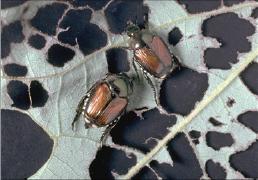
Adult Japanese beetles
Control
From a management standpoint, it is important to recognize that both the adults and grubs can cause damage. Moreover, since Japanese beetle adults are capable of flying in from other areas, controlling one life stage will not preclude potential problems with the other. Options for protecting trees, shrubs, and flowers from adult Japanese beetles are presented below. Control of the grub stage requires properly timed applications of a soil insecticide to infested turf. Diagnosis and control of white grubs in turf is discussed in a companion publication, Kentucky Cooperative Extension Service publications ENT-10, "Controlling White Grubs" and Entfact 441, "Insecticides for Controlling of White Grub in Kentucky Turfgrass."
Plant Selection
Careful selection of plant species when replacing or adding to your landscape is the key to avoiding annual battles with Japanese beetles. Some species and cultivars are highly preferred by the adults and should be avoided where the beetle is abundant. Plants that are especially prone to damage include roses, grapes, lindens, sassafras, Norway maple, Japanese maple, purple-leaf plum, and others (Table 1). Many varieties of flowering crabapples are also severely attacked by the beetles, although some cultivars are resistant.
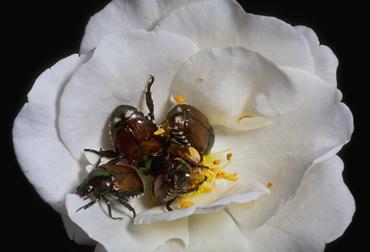
Roses are highly susceptible to Japanese beetles
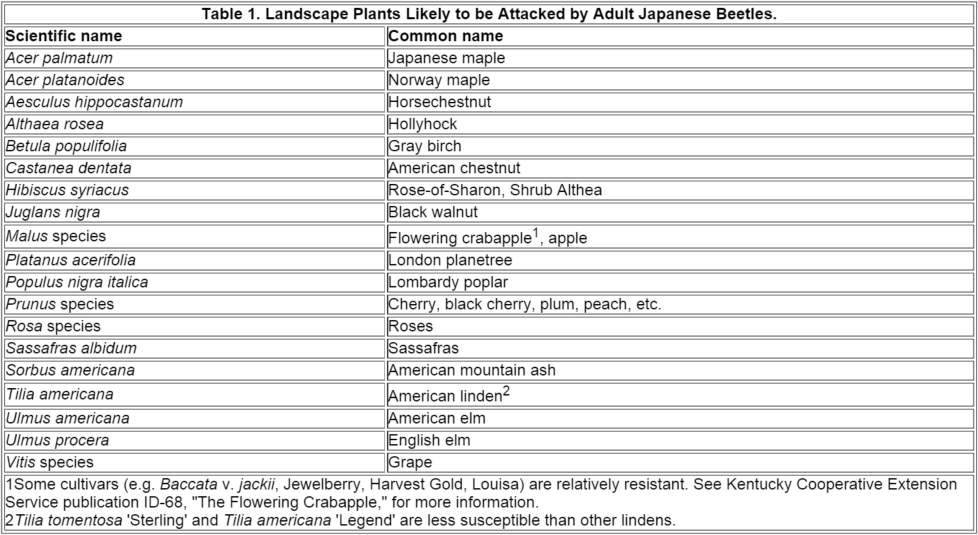
Fortunately, many common trees and shrubs are much less attractive to Japanese beetles (Table 2). These differences in susceptibility should be considered when selecting plant species and cultivars for use in Japanese beetle-infested areas.
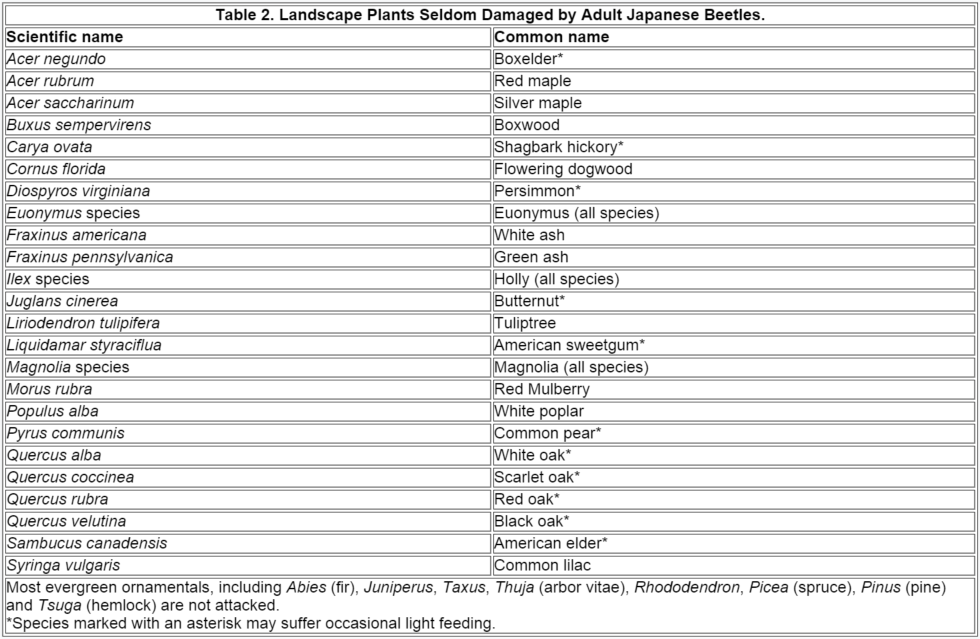
Japanese beetles are also fond of certain weeds and non-cultivated plants such as bracken, elder, multiflora rose, Indian mallow, poison ivy, smartweed, and wild grape. Elimination of these plants whenever practical destroys these continuous sources of infestation.
Although plant selection is important, other approaches must obviously be used to protect susceptible plants that are already established in landscapes.
Physical Removal and Exclusion
Removing beetles by hand may provide adequate protection for small plantings, especially when beetle numbers are low. The presence of beetles on a plant attracts more beetles. Thus, by not allowing beetles to accumulate, plants will be less attractive to other beetles.
One of the easiest ways to remove Japanese beetles from small plants is to shake them off early in the morning when the insects are sluggish. The beetles may be killed by shaking them into a bucket of soapy water. Highly valued plants such as roses can be protected by covering them with cheesecloth or other fine netting during the peak of beetle activity.
Chemical Control
Many insecticides are labeled for use against adult Japanese beetles. Examples include pyrethroid products such as cyfluthrin (Tempo, Bayer Advanced Lawn & Garden Multi-Insect Killer), bifenthrin (TalstarOne, Onyx), deltamethrin (Deltagard), lambda cyhalothrin (Scimitar, Spectracide Triazicide), esfenvalerate (Ortho Bug-B-Gon Garden & Landscape Insect Killer) and permethrin (Spectracide Bug Stop Multi-Purpose Insect Control Concentrate and other brands). Carbaryl (Sevin and other brand names) too is effective. The pyrethroid products generally provide 2-3 weeks protection of plant foliage while carbaryl affords 1-2 weeks protection. For those seeking a botanical alternative, Neem products such as Azatrol or Neem-Away (Gardens Alive), or Pyola (pyrethrins in canola oil) provide about 3-4 days deterrence of Japanese beetle feeding. Insecticidal soap, extracts of garlic, hot pepper, or orange peels, and companion planting, however, are generally ineffective.
With all products, foliage and flowers should be thoroughly treated. The application may need to be repeated to prevent reinfestation during the adult flight period. Follow label directions and avoid spraying under windy conditions or when bees are foraging. Be sure the insecticide is registered for use on the plant or crop you intend to spray. If it is a food crop, note the minimum number of days that must be observed between the date of the last application and the date of harvest.
Because Japanese beetles are attracted to favored host plants from a considerable distance, controlling white grubs in the lawn will not protect landscape plants from adult feeding.
Japanese Beetle Traps
Japanese beetle traps are sold in many garden centers. Commercially available traps attract the beetles with two types of baits. One mimics the scent of virgin female beetles and is highly attractive to males. The other bait is a sweet-smelling food-type lure that attracts both sexes. This combination of ingredients is such a powerful attractant that traps can draw in thousands of beetles in a day.
Unfortunately, research conducted at the University of Kentucky showed that the traps attract many more beetles than are actually caught. Consequently, susceptible plants along the flight path of the beetles and in the vicinity of traps are likely to suffer much more damage than if no traps are used at all.
In most landscape situations, use of Japanese beetle traps probably will do more harm than good. If you experiment with traps, be sure to place them well away from gardens and landscape plants.
Mention or display of a trademark, proprietary product, or firm in text or figures does not constitute an endorsement and does not imply approval to the exclusion of other suitable products or firms.
Issued: 1/06
Revised: 1/06
CAUTION! Pesticide recommendations in this publication are registered for use in Kentucky, USA ONLY! The use of some products may not be legal in your state or country. Please check with your local county agent or regulatory official before using any pesticide mentioned in this publication.
Of course, ALWAYS READ AND FOLLOW LABEL DIRECTIONS FOR SAFE USE OF ANY PESTICIDE!
Photos: Dan Potter, University of Kentucky Entomology. Beetle life cycle diagram: J. Kalisch, University of Nebraska
